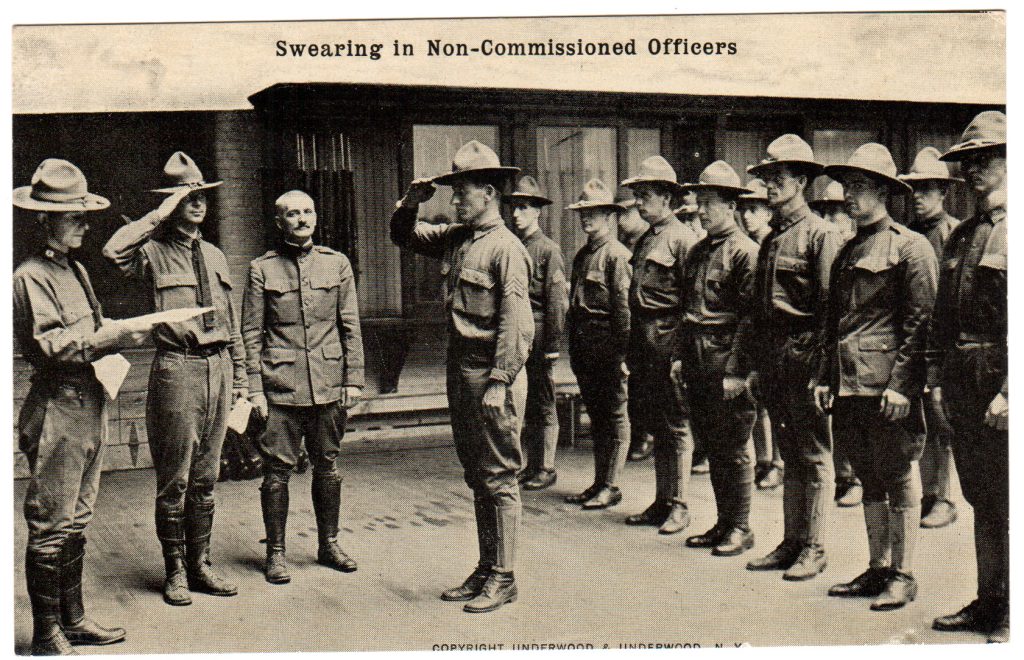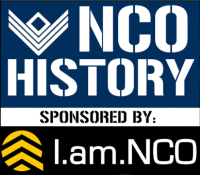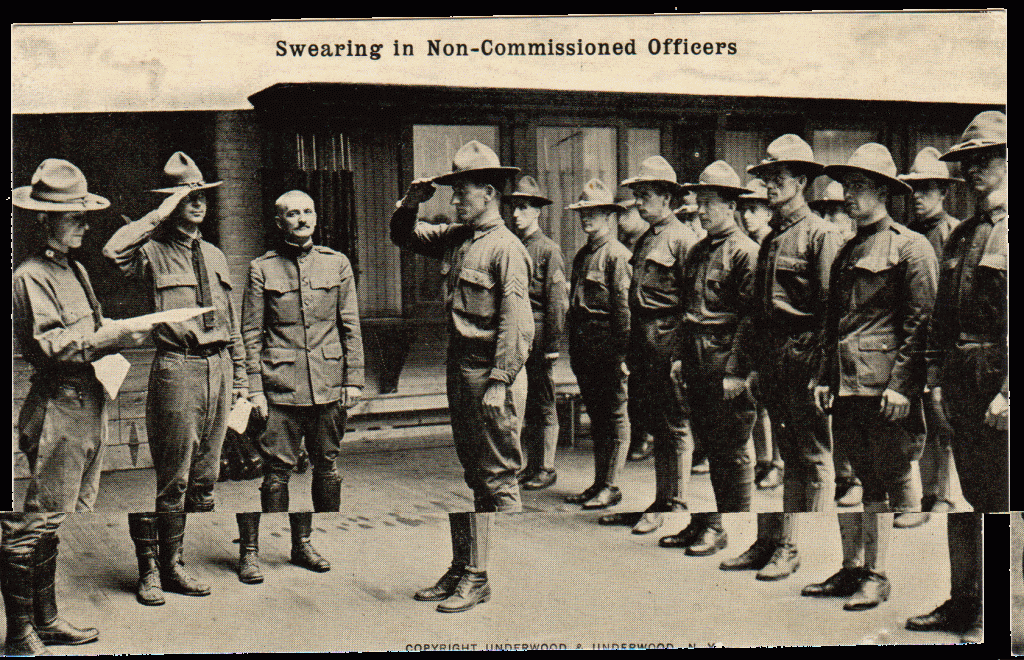
Script for NCO Induction Ceremony
For many years senior noncommissioned officers have upheld the induction ceremony tradition, yet there are no official documents that capture what it should comprise or how it is to be conducted. Ideas have been shared and passed on from one senior sergeant to another.
The importance of crossing over from an enlisted soldier to a noncommissioned officer is a milestone in an enlisted soldier’s career and should not be taken lightly. It is the responsibility of senior NCOs to ensure we continue this tradition for many years to come.
Promotion Ceremony
The importance of recognizing the transition from “just one of the guys or gals” to a noncommissioned officer should be shared among the superiors, peers, and subordinates of the newly promoted. This action allows the commander, the ultimate approving authority for the promotion of enlisted soldiers within their charge, to serve their role in the process. The induction ceremony should be held separate, and to serve as an extension of the promotion ceremony. Typical Army promotion effective dates occur on the first day of a month, and when possible, so should the induction ceremony.
Induction Ceremony Purpose
The induction ceremony is a celebration of the newly promoted joining the ranks of a professional noncommissioned officer corps, and emphasizes and builds on the pride we all share as members of such an elite corps. The ceremony should also serve to honor the memory of those men and women of the NCO Corps who have served with pride and distinction.
Induction ceremonies should in no way be used as an opportunity for hazing, but more as a rite of passage. It allows fellow NCOs of a unit to build and develop a cohesive bond, support team development, and serve as a legacy for future NCO Induction Ceremonies.
The NCO Induction Ceremony is typically conducted at the Battalion (or equivalent) level. Though it can be held at higher or lower levels, this document will focus on the principles for executing a Battalion NCO Induction Ceremony. By changing the titles of key NCO leaders to meet your own need, you can tailor this document to your own organization.
Induction Ceremony Location
Though the location of the ceremony is not as important as the content, there are some considerations that should be acknowledged. As part of the socialization process of newly promoted noncommissioned officers, the induction ceremony should be held in a social meeting area, such as NCO, community, or all-ranks club. Alternately, a well-equipped gymnasium, post theater, or for smaller ceremonies, a unit dayroom could be used. Chapel use is discouraged for concerns of “ritualistic” or “mystic” overtones that may be perceived, of which goes directly against the intended result (see Induction Ceremony Purpose)
Timing
As part of the socialization process for new noncommissioned officers, the Induction Ceremony should be scheduled as a training event on the training calendar. The formal portion should take place during the duty day, prior to retreat. By making it a training event during duty hours, you not only get maximum participation, but command support (Commanders approve training schedules). The optimum time is 1630 to 1700 for the formal portion (the ceremony), and 1700-1730 for the informal portion (greetings, congratulations and socializing).
Key Personnel
As the senior NCO of the command, the Battalion Command Sergeant Major serves as the host of the NCO Induction Ceremony. The unit First Sergeants are the CSM’s assistants, and they compose the “Official Party.” If desired, a guest speaker for the ceremony may be included, and also is a part of the official party. A narrator will serve as the Master of Ceremonies.
Invited Guests and VIPs
As a wholly noncommissioned officer sponsored event, guests and VIPs should be limited to current and former U.S. Army NCOs. Certain situations may warrant an officer or civilian to attend, and will not detract from the nature of the occasion. Typical invited guests could include higher echelon Command Sergeants Major (Brigade, Division, Regimental, Commandant), Installation or Base Support Battalion (BSB) Command Sergeants Major, or even lateral (Battalion level) Command Sergeants Major. Additionally, special guests serving as motivational speakers should be included (though not required) as part of an induction ceremony.
Equipment Required
Though each ceremony should be as different as the people it recognizes, a commonality should be shared between them. The following items should be available for each:
- A passage of a citation for bravery or valor in the face of difficulty demonstrated by a noncommissioned officer. With access to the World Wide Web and Internet, citations are easily accessed and printed from such sites as army.mil, www.awod.com/gallery/probono/cmhs or various books.
- Copies of the NCO Creed. 1-per inductee. Available through many sources.
- Army Training Circular 22-6, The Army Noncommissioned Officer Guide, dated November 1990. 1-per inductee. This book was dedicated to the future NCOs who will carry the torch passed on to them. Available from normal publication channels.
- Sound system (optional). Requirement based only on the number present, and the “command voice” of the participants.
- Programs (includes the words to the NCO Creed) Optional
Ceremony
This ceremony is a “living” process, which means it was developed to grow and mature with the different users. The intent is to give a common basis from which to begin, and then tailor it to suit your specific needs. Though the ceremony is not “THE” correct ceremony, rather, it is “A” ceremony, one based on the intent of presenting a professional NCO Induction Ceremony.
PLACES: Official party – Waiting outside the ceremony room.
Narrator – At the sound system/podium.
Inductees – Formed in advance at an appropriate location. Each should have a copy (or portion) of the NCO Creed.
(2-minutes before ceremony begins)
NARRATOR: Ladies and Gentlemen, the ceremony will begin in two minutes.
(At the predetermined time)
NARRATOR: Please rise for the official party.
(Official party arrives, marches to designated location. Stops, then takes appropriate positions)
NARRATOR: Welcome to (this months) (month name) NCO Induction Ceremony where we recognize the passing of the group before you (the inductees) into the ranks of the time-honored United States Army Noncommissioned Officer Corps. Today’s official party consists of (names).
The tradition of commemorating the passing of a soldier to a noncommissioned officer can be traced to the Army of Fredrick the Great. Before one could be recognized in the full status of a NCO, he was required to stand four watches, one every four days. At the first watch the private soldiers appeared and claimed a gift of bread and brandy. The company NCOs came to the second watch for beer and tobacco, and the First Sergeant reserved his visit for the third watch, when he was presented with a glass of wine and a piece of tobacco on a tin plate[1]. Today, we commemorate this rite of passage as a celebration of the newly promoted joining the ranks of a professional noncommissioned officer corps, and emphasize and build on the pride we all share as members of such an elite corps. We also serve to honor the memory of those men and women of the NCO Corps who have served with pride and distinction. Today, we remember one of our own, one whose courage should not go unremembered:
NARRATOR: (read citation. Include name, unit, etc.)
NARRATOR: Since the earliest days of our Army, the noncommissioned officer has been recognized as one who instills discipline and order within a unit. In his instructions for the “Sergeants and Corporals,” Baron Friedrich Wilhelm von Steuben, the U.S. Army’s first “Drill-Master” listed in his Regulations for the Order and Discipline of the Troops of the United States, the Blue Book that: “Each Sergeant and Corporal will be answerable for the squad committed to his care. He must pay particular attention to their conduct in every respect and that they keep themselves and their arms always clean. In dealing with recruits, they must exercise all their patience and while on the march, the noncommissioned officers must preserve order and regularity.”
Today, we continue that tradition. (Name), our (guest speaker)(CSM) now will share his/her instructions with our newest Sergeants and Corporals.
SPEAKER: (motivational speech)
NARRATOR: The Creed of the Noncommissioned Officer has served as a guiding document for noncommissioned officers since its inception in 1973, though its concepts have been always been a part of our Corps. Each major paragraph begins with three letters: N, C, and O. These words have inspired noncommissioned officers, and have served as a compass to guide us down the right paths that we encounter. Today, our newest noncommissioned officers will affirm their commitment to the professionalism of our corps, and become a part of the “Backbone” of the Army.
(Inductees rise)
Option 1 Inductees all simultaneously read the NCO Creed.
Option 2 Divide the NCO Creed into equal parts, based on the number of inductees. Have each inductee read their portion, in sequence.
Option 3 Have all present read the NCO Creed together (note. provide copies in advance to all present).
CSM/HOST: Moves to each inductee, issues them a copy of TC 7-22.7, Noncommissioned Officer Guide, then shakes their hand and congratulates them.
ALL PRESENT: Applause.
NARRATOR: As we conclude today’s ceremony we ask you to greet our newest inductees, and join us in welcoming them to the Corps. Please rise for the exit of the official party.
OFFICIAL PARTY: Departs. Ceremony ends. Informal portion begins (socializing).
[ǂ] Based on the 1998 Unofficial Guide for Newly Inducted NCO’s written by the author CSM Daniel K. Elder

